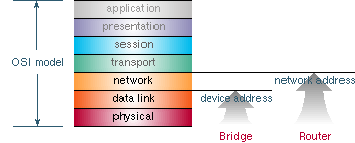Bridging vs Routing
A bridge is a device that connects different networks to each other and operates through layers one and two of the OSI model, the physical and data link layers.
A router operates through the first three layers of the OSI model, which adds the network layer to its range of known information.
Bridges can find devices in a connected network because device addresses are carried in layer two, which is also called the MAC (media access control) layer. Bridges cannot find specific network protocol addresses (such as IP or subnet addresses; or IPX or Appletalk addresses) because that information is carried in layer three.
Routers can find discreet network addresses when they are configured to work with that particular protocol. Configuring a router to work with a protocol requires software for each protocol that the router must negotiate.
Routers learn optimum paths to network destinations by keeping up-to-date information in routing tables.
When should you bridge or route?
You bridge when you are connecting networks of the same type (such as all IP, or all IPX). You route when you are connecting different types of networks (such as connecting and IP network to an IPX network). From a practical point of view, you should always route if possible, as routing is more efficient and makes call management easier. Bridging is necessary when you cannot subnet your IP network, and when you need to use non-routable protocols such as NetBIOS, or DECnet.
Overall, bridging is very easy to configure and allows you to connect to a ne

